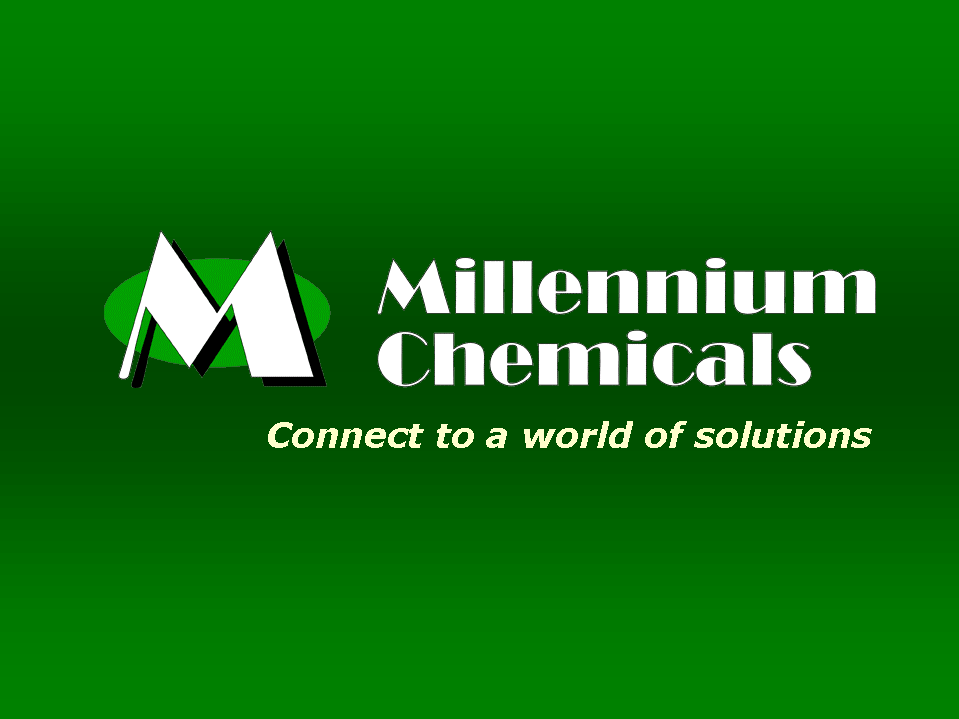THIRD QUARTER 2002
ANALYST CONFERENCE CALL
October 30, 2002
Mickey Foster
Vice President, Corporate and Investor Relations

Introduction – Good morning and thank you for participating in Millennium Chemicals analyst conference call and welcome to those participants on the Internet. Today we will cover results for the third quarter and our outlook. Speakers include Jack Lushefski, our SVP and Chief Financial Officer, Mickey Foster, VP of Corporate and Investor Relations, and Bob Lee, Executive Vice President of Growth and Development.
As we announced in the invitation to this conference call, you can view the slides and listen to our presentation live by accessing our website (www.millenniumchem.com) and clicking on the Investor Relations icon.
The slides available to our Internet participants are meant as an enhancement tool and they contain information which is either in our press release or which we will discuss during this presentation.
Here are two instructions for our Internet participants:
First, in addition to asking questions on the conference call as you have traditionally done, you can ask questions by clicking on the “send question” button located on the left hand portion of your screen and we will respond to them live during the Q&A portion of this conference call.
Second, the slides will automatically move forward during the presentation on your screen.
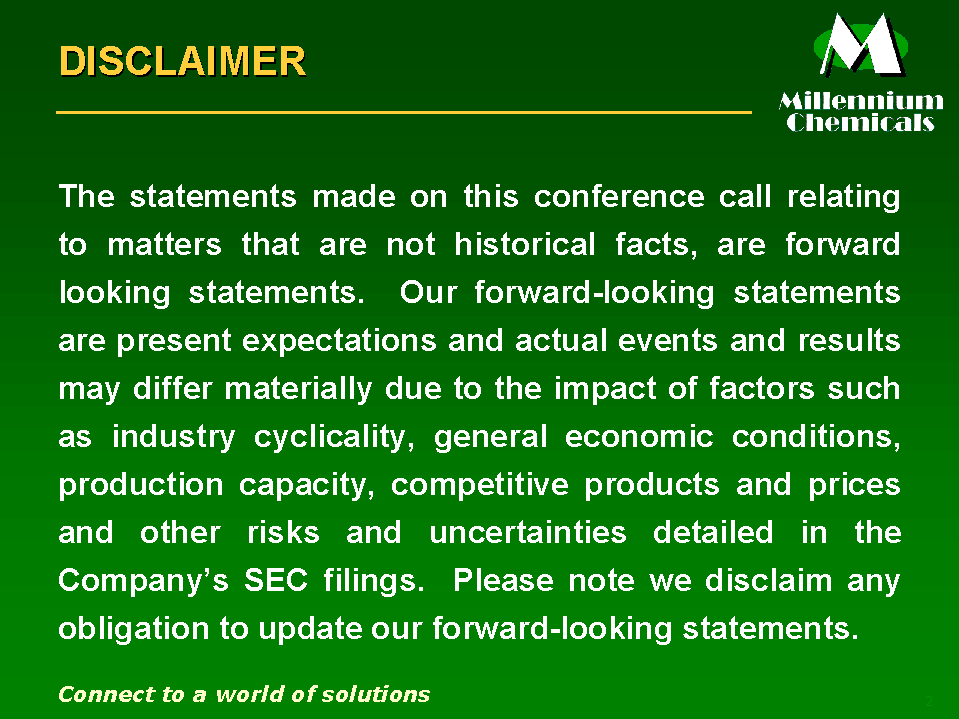
Before we start, our lawyers asked me to preface with our safe harbor legal statement: The statements made on this conference call relating to matters that are not historical facts, are forward looking statements. Our forward-looking statements are present expectations and actual events and results may differ materially due to the impact of factors such as industry cyclicality, general economic conditions, production capacity, competitive products and prices and other risks and uncertainties detailed in the Company’s SEC filings. Please note we disclaim any obligation to update our forward-looking statements.
Jack will begin and cover the financials. I will cover TiO2, Acetyls, Specialty chemicals and Equistar. Bob will then cover Growth and Development. Then we will be glad to answer questions. Jack....
John E. Lushefski
Sr. Vice President & Chief Financial Officer
Thanks Mickey. I would now like to review some details of Millennium's reported results for the third quarter and our financial position at the end of September 2002.

Millennium reported consolidated pro forma EBITDA of $100 million for the third quarter of 2002, which was $37 million more than the $63 million reported for the third quarter of 2001 and $26 million more than reported for the second quarter of 2002. EBITDA was better than or about equal to third quarter levels last year for all operating segments, including Equistar. Sequential comparisons of third quarter 2002 EBITDA to second quarter 2002 levels were favorable for all wholly owned business segments, except Specialty Chemicals, which was flat and considerably higher for our share of Equistar. For our wholly owned business segments in the aggregate this was the third quarterly sequential increase in EBITDA, a positive trend that reflects improving supply/demand fundamentals and the results of our cost control efforts. Mickey and Bob will discuss individual business segment performance when I complete my comments.
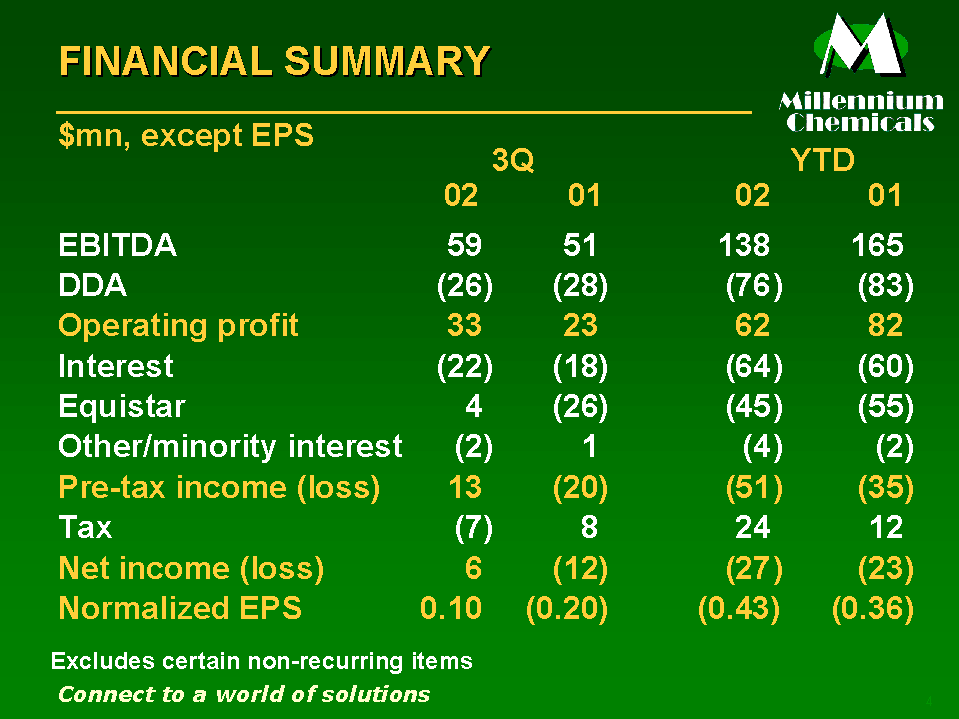
Moving to Millennium’s financial summary for the third quarter . . . the Financial Summary slide provides abbreviated Statements of Operations to arrive at normalized earnings, which exclude certain unusual items.
- Operating income was $33 million, up from the third quarter of last year when $23 million was earned, and better than the second quarter of 2002 when we made $18 million at the operating income line.
- Third quarter net interest expense was $22 million, $4 million more than the third quarter of 2001 and about equal to the expense level of the second quarter of 2002. Interest expense in the third quarter of 2001 reflected higher gains recognized from market adjustments to interest rate swap agreements. Excluding those gains, interest quarter-on-quarter as compared to last year was about flat. Average net debt levels during the third quarter this year were less than average net debt levels during the third quarter last year.
- Equistar’s operations, on an after interest basis, generated a profit of $4 million for Millennium in the third quarter of 2002, much better than a loss of $26 million in the third quarter last year and much improved from a loss of $10 million in the second quarter of 2002.
- The income tax benefit percentage that we estimate for the full year of 50% has not changed from the estimate in the second quarter.
- Net income for the quarter was $6 million or 10 cents per share versus a net loss of $12 million or 20 cents per share for the third quarter last year.
- Net income for the third quarter of 2002 and 2001 on this slide are equal to net income on our Consolidated Statements of Operations since we did not record any unusual items in either of these quarters.
- The net year-to-date losses reflected on slide 4 exclude certain unusual items that are described on the next slide.

Moving to slide 5 . . . this slide provides a reconciliation from our reported year-to-date net losses to the normalized figures I provided and discussed on slide 4. Last year we recorded plant closure and reorganization charges. For the year-to-date figures this year, we added back the effect of our goodwill write-off that was recorded in the first quarter.
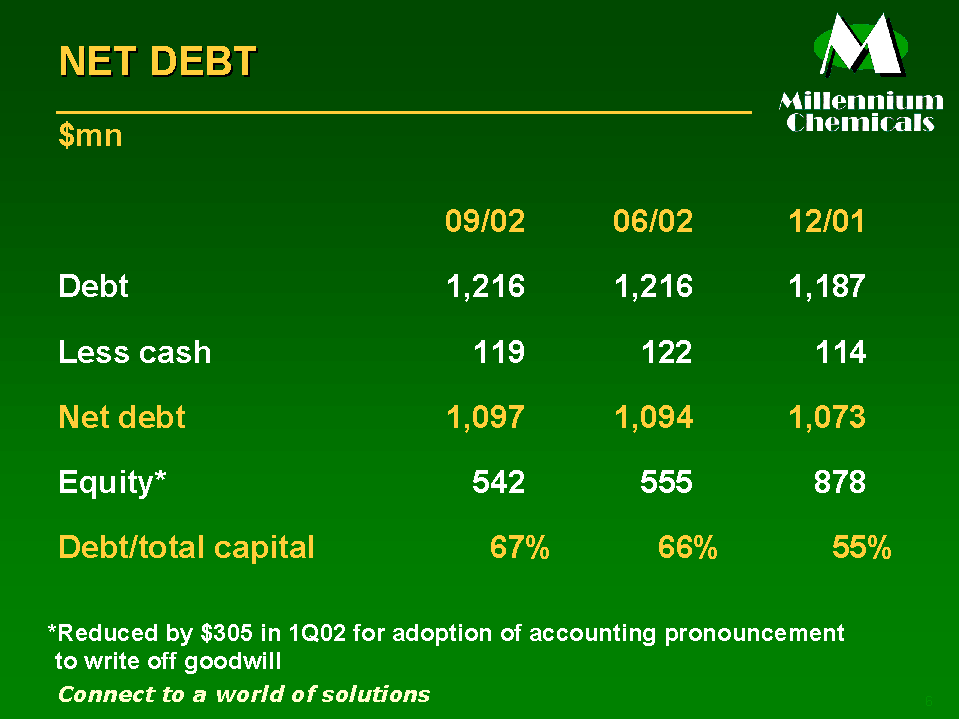
Let’s move to a discussion of our balance sheet and cash flow. Net debt at the end of the quarter as shown on slide 6 is slightly less than $1.1 billion, a balance that is about the same as our net debt balance at the beginning of the quarter. Our net debt-to-total capital percentage is 67 percent at the end of the quarter, up 11 percentage points from the end of 2001 due primarily to the change in accounting for goodwill. We had $119 million of cash and cash equivalents on hand at the end of the quarter and there were no borrowings outstanding under our $175 million revolving credit facility.
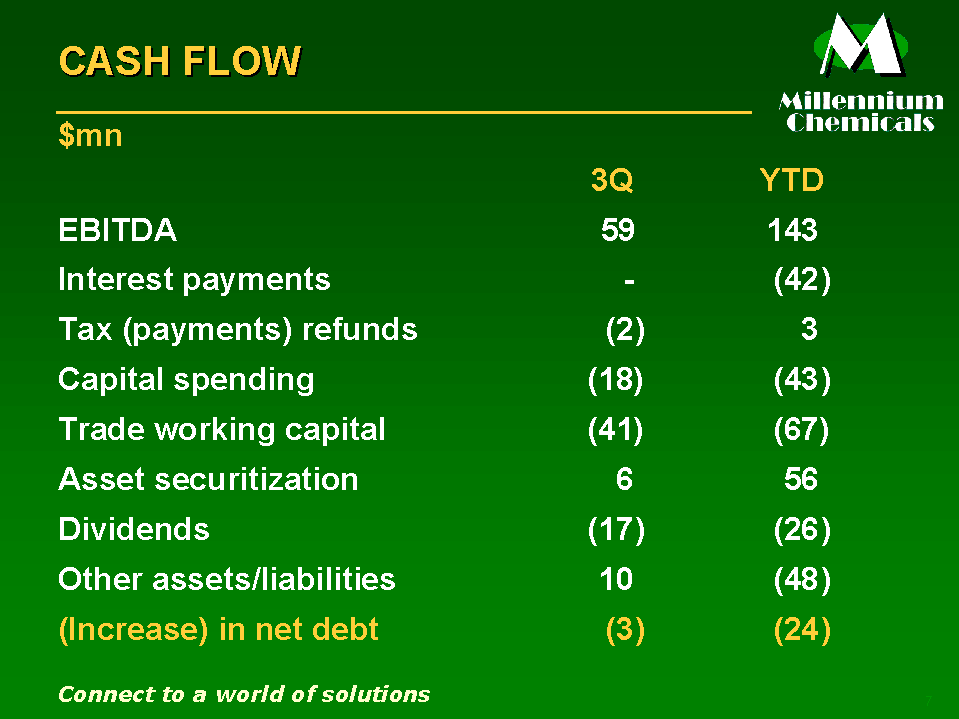
Turning to our cash flow summary on slide 7 . . . Cash used for capital spending remained at a low level as we continue to critically review these expenditures. Capital expenditures for all of 2002 are expected to be in a range of $60-65 million.
- Trade working capital, defined as accounts receivable plus inventories less accounts payable, increased during the quarter and was a use of $41 million in cash.
- Accounts receivable increased during the quarter as volumes remained strong and prices improved in our major businesses from lower levels in the second quarter. Inventories increased due to an increase in raw materials, which was only partially offset by a decrease in finished goods inventories. Trade payables were slightly lower at the end of the quarter.
- We added $6 million to our European accounts receivable securitization
- Due to the timing of the dividend payment at the end of the second quarter, dividends paid were $17 million versus the usual $8.5 million.
- The source of cash from other assets and liabilities relates to the movement of all other balance sheet accounts affected by the seasonal timing of payments for items such as insurance, pensions and other payroll related costs.
- We did not receive a distribution from Equistar during the quarter and do not expect distributions in 2002.
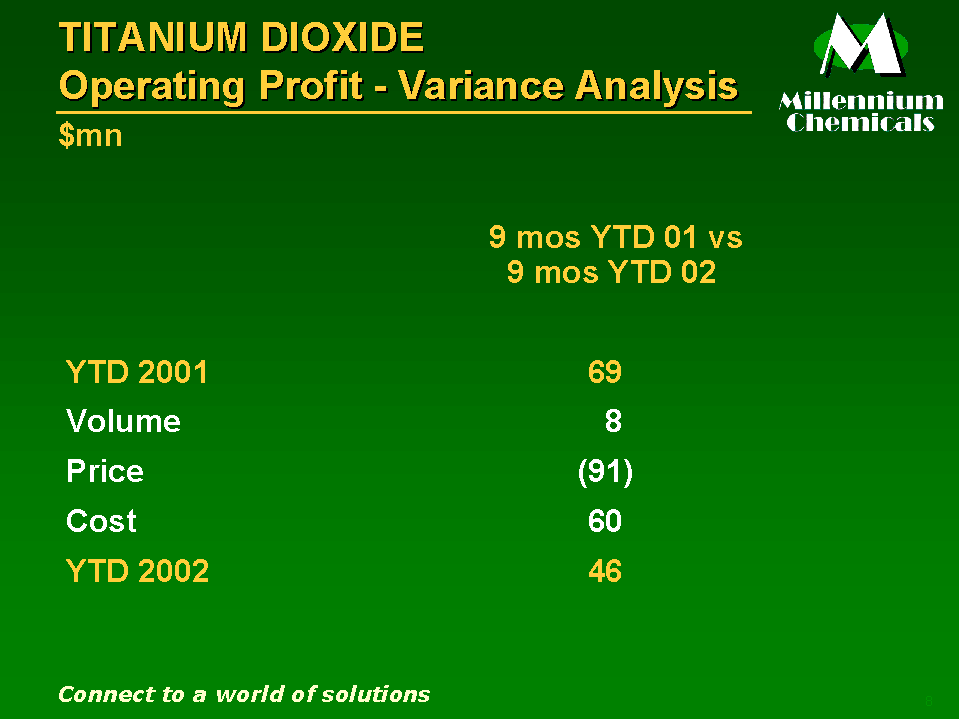
Turning to slide 8 . . . We are very pleased with our employees efforts to control costs. Slide 8 reconciles YTD operating profit in our TiO2reporting segment from 2001 to 2002. As you can see from the figures, adverse price variances have reduced our profitability in our largest wholly owned segment by more than $90 million, but we have managed to make up for $60 million of that by finding ways to reduce costs. Considering that raw material costs in this segment have been relatively stable, we consider this a significant achievement that will continue to benefit Millennium as business conditions improve.
In closing I will repeat that all of our employees’ are focused on cost control and capital efficiency. These intense efforts will continue in 2002 and become part of our business plan for 2003.
Now, I’ll turn it over to Mickey who will discuss some details about performance in our TiO2 and Acetyls business segments.
Mickey Foster
Vice President, Corporate and Investor Relations
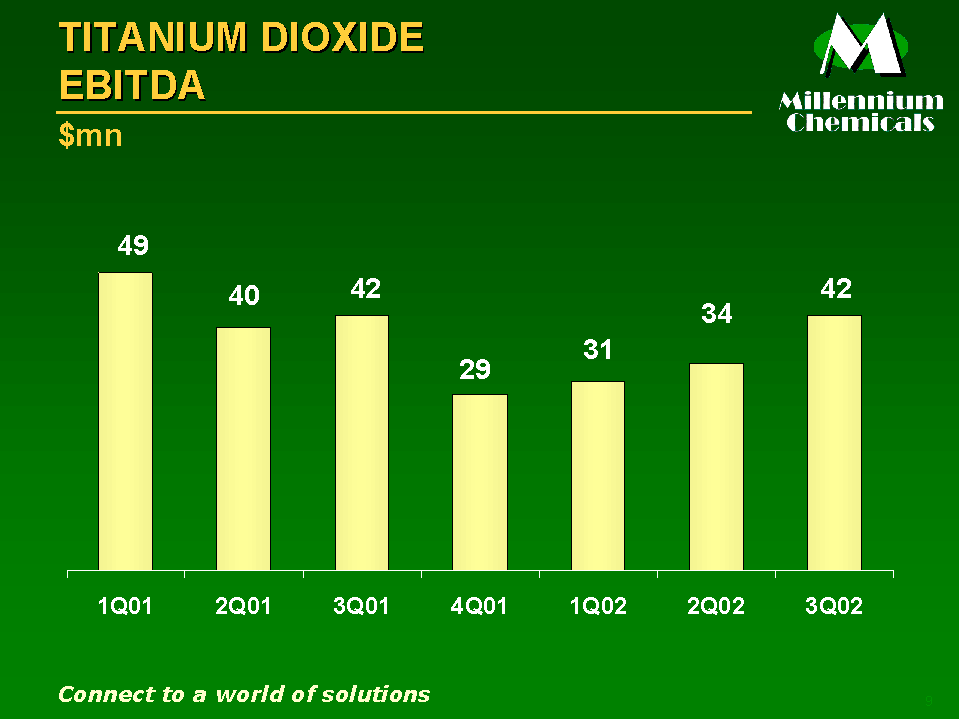
Thanks Jack. TheTitanium Dioxide (TiO2) segment reported third quarter EBITDA of $42 million, equal to the third quarter of last year and up from $34 million in the second quarter of 2002. The increase in third quarter EBITDA when compared to the second quarter reflected higher prices offset partially by seasonally lower volumes.
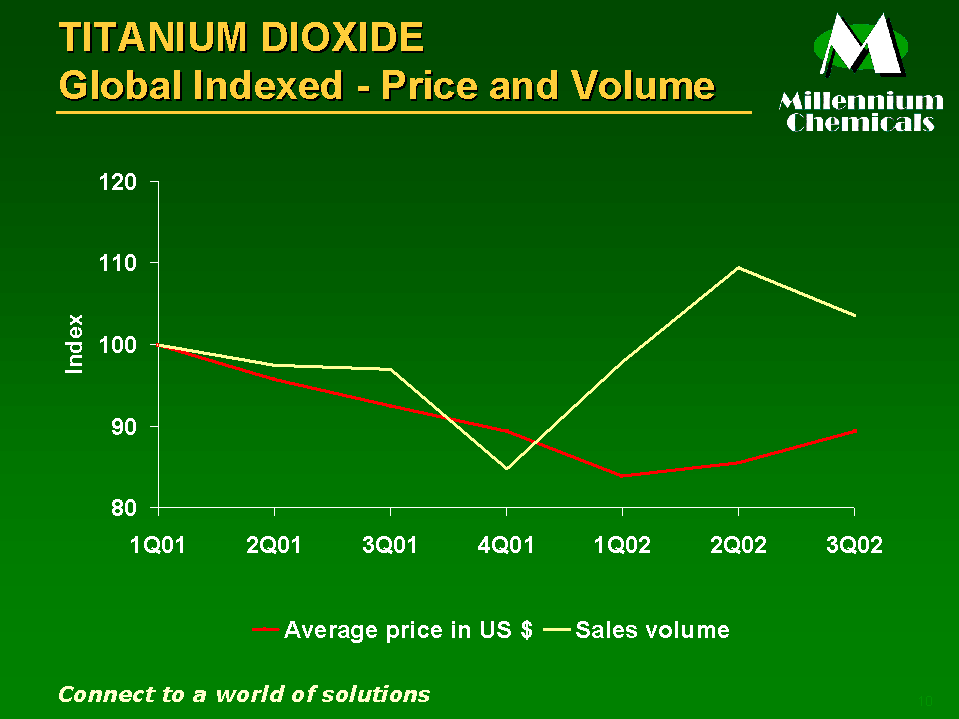
Third quarter TiO2 sales volume of 161,000 metric tons increased 7 percent from the third quarter of last year and seasonally decreased 5 percent from the second quarter of 2002. Year-to-date sales volume of 485,000 metric tons was 6 percent higher than volume for the same period of last year.
In local currencies, average third quarter prices were down 6 percent from last year’s third quarter, and up 3 percent from the second quarter of 2002. In US dollar terms, the worldwide average third quarter price was down 4 percent from the same quarter last year and was 5 percent higher than the second quarter of 2002. June 2002 announced price increases (effective July 2002) for coatings and plastics are in the process of being implemented.
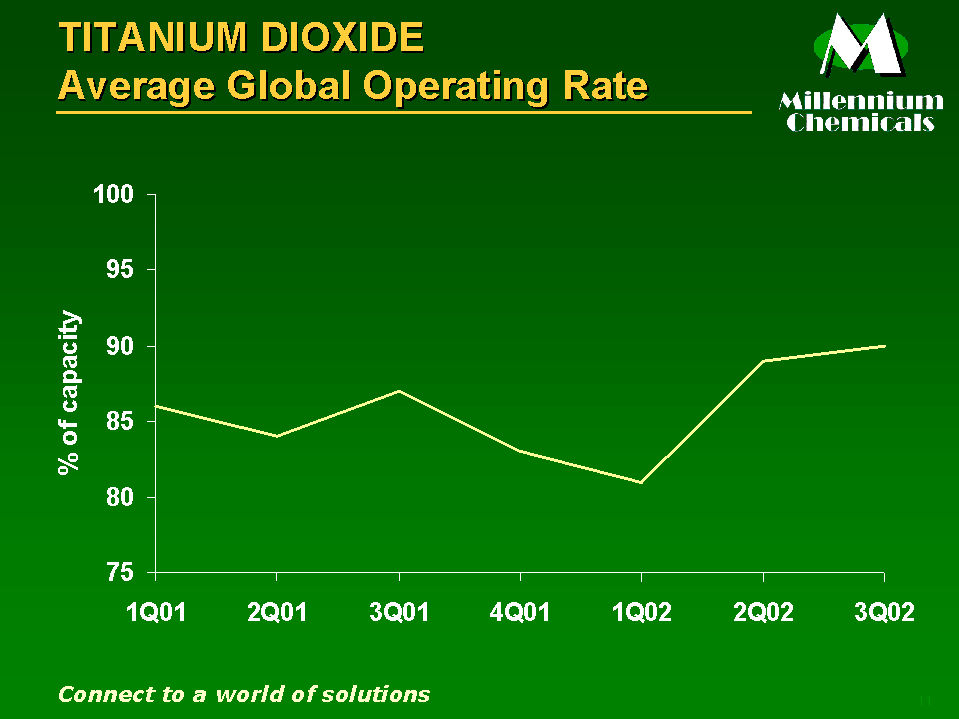
The third quarter’s TiO2 plant production operating rate was 90 percent of annual nameplate capacity of 690,000 metric tons. This represented an increase over the operating rate of 87 percent in last year’s third quarter and was slightly higher than the 89 percent operating rate in the second quarter of 2002.

Sales volume in the fourth quarter of 2002 is anticipated to be seasonally lower than the third quarter, but ahead of last year’s fourth quarter. Previously announced price increases should be gradually obtained, with the extent and timing dependent on a continuation of the current pattern of increased year-on-year demand. Finished goods inventories in the third quarter were at historic lows as the benefit of infrastructure investments in our ERP system have dramatically reduced the working capital investment necessary to meet our customers’ needs.
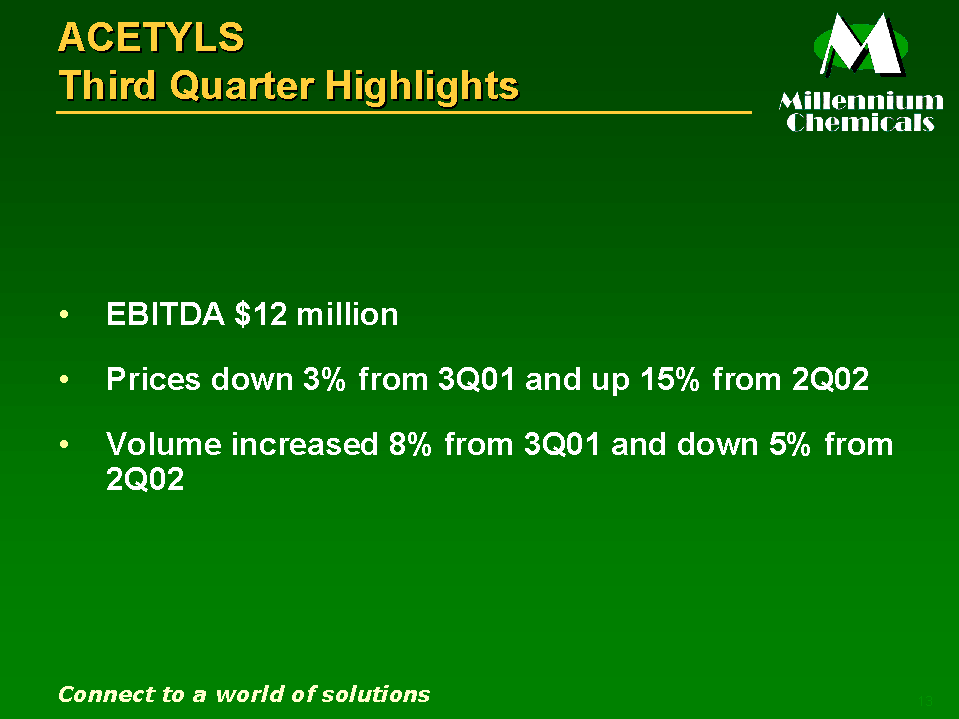
TheAcetyls segment reported third quarter 2002 EBITDA of $12 million, which was up from $2 million in the third quarter of last year, and $7 million in second quarter of 2002. EBITDA in the third quarter of 2002 increased over the second quarter of 2002 primarily as a result of higher prices on relatively flat sales volumes.
prices in the third quarter of 2002 decreased 3 percent from prices in the third quarter of last year and increased 15 percent from the second quarter of 2002. Acetyls volume in the third quarter increased 8 percent from the comparable period of last year and decreased 5 percent from the second quarter of 2002.
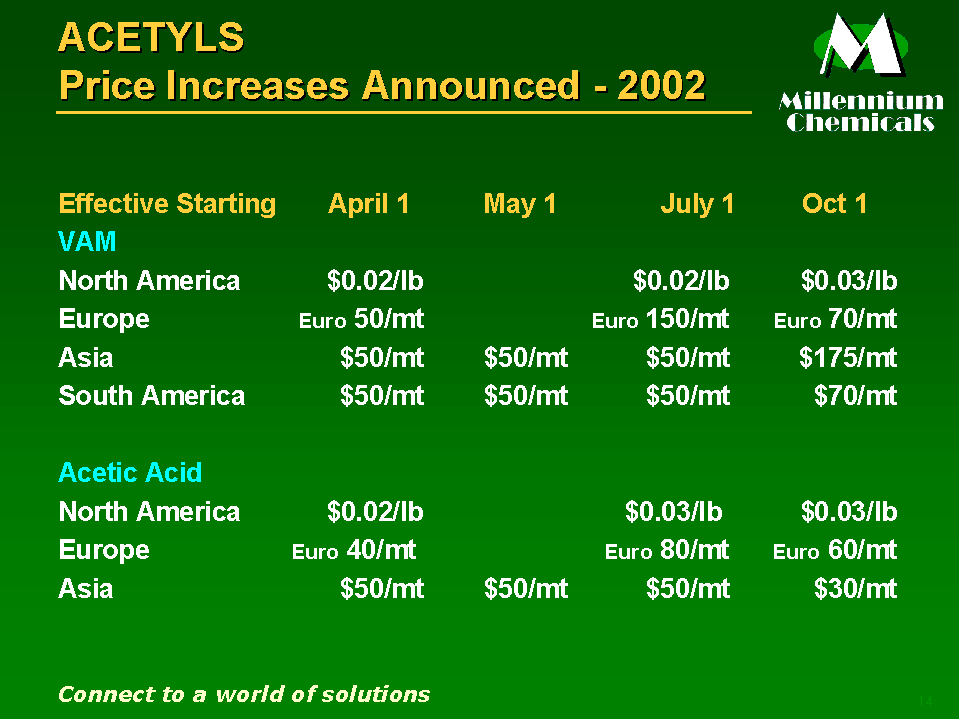
On October 1, 2002, Millennium announced a VAM price increase of $0.03 per pound in North America, $70 per metric ton in South America, 70 euros per metric ton in Europe and $75 per metric ton in Asia. The $75 per metric ton increase in Asia was on top of the $100 per metric ton on August 1. Millennium also announced price increases effective October 1 in acetic acid of $0.03 per pound in North America, 60 Euros per metric ton in Europe and $30 per metric ton in Asia.
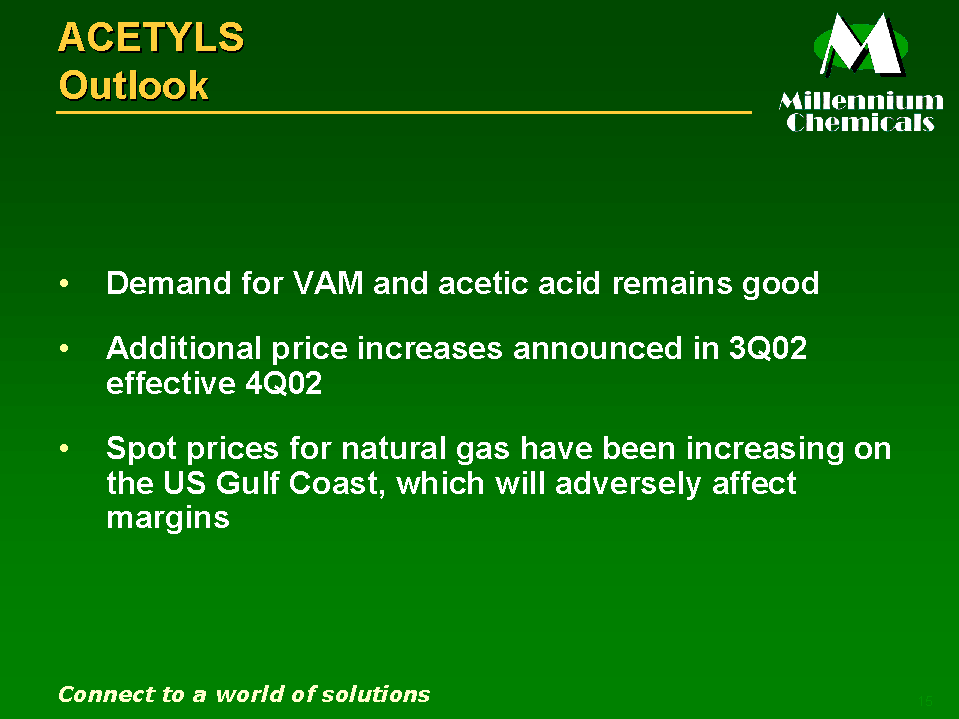
Acetyl’s volume and price should remain strong in the fourth quarter, although margins are currently being negatively affected by higher natural gas feedstock costs. Industry natural gas prices on the US Gulf Coast averaged about $3.20 per MMBTU in the third quarter of 2002. In October, average natural gas spot pricing on the US Gulf Coast was approximately $4.10 per MMBTU. At current levels of natural gas pricing, profits in the fourth quarter of 2002 will likely be lower when compared to the third quarter of 2002, even though previously announced price increases should be obtained during the quarter.
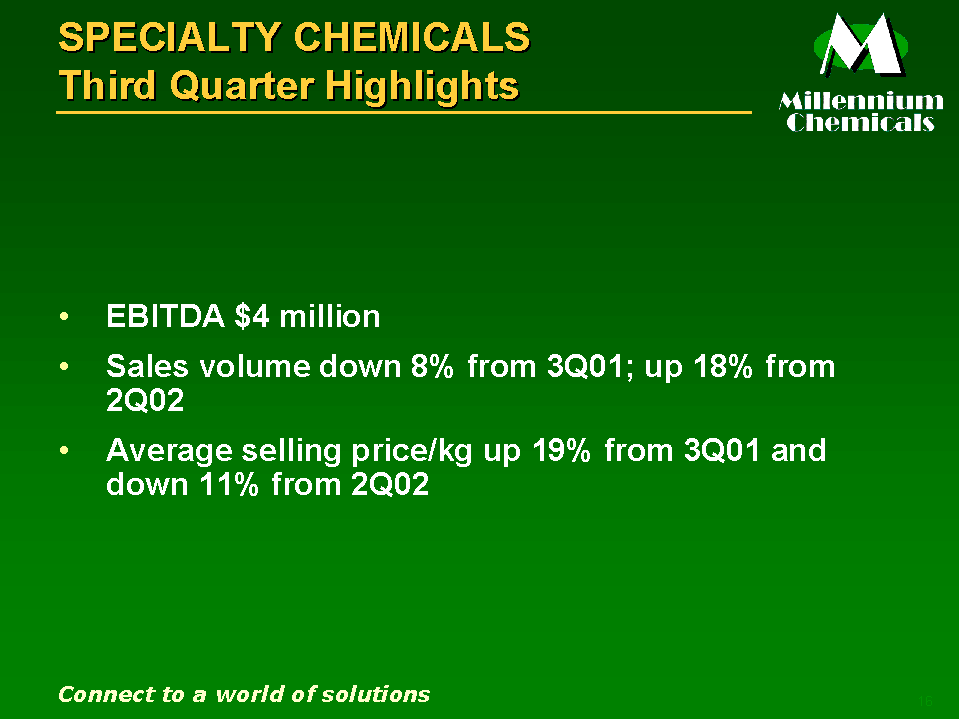
The Specialty Chemicals segment reported third quarter 2002 EBITDA of $4 million compared to $5 million in the third quarter of last year and flat with the second quarter of 2002. Sales volume was down 8 percent from last year’s third quarter and was up 18 percent from the second quarter of 2002.
Average selling prices increased 19 percent compared to last year’s third quarter and declined 11 percent from the second quarter of 2002. Selling prices have declined due to industry oversupply in certain fragrance chemical product lines. Bob will cover the Outlook for this segment in his remarks.
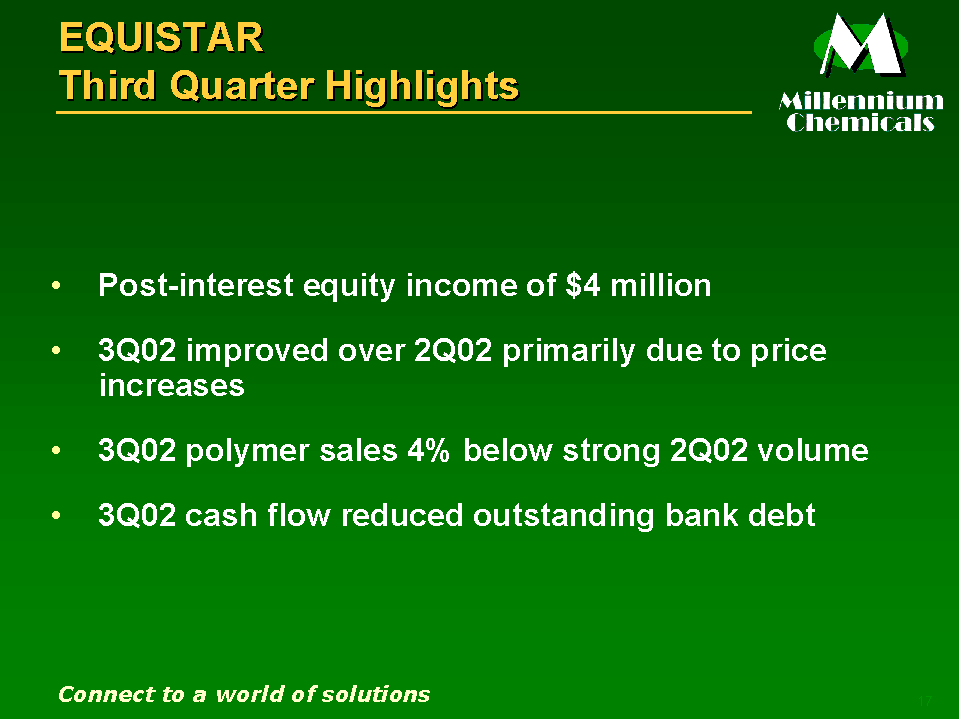
Millennium’s 29.5 percent stake in Equistar reported third quarter post-interest equity income of $4 million compared to ($26) million of equity loss in the third quarter of last year and a ($10) million equity loss in the second quarter of 2002.
Equistar’s performance improved in the third quarter from the second quarter primarily as a result of price increases that were implemented during the second quarter. However, over the course of the third quarter, the benefit was gradually eroded by higher raw material costs.
Polymer sales volume in the third quarter was approximately 4 percent below strong second-quarter volume.
Equistar did not distribute any cash to Millennium in the third quarter, and distributions are not expected until profit levels improve. Equistar produced sufficient cash flow in the third quarter, which enabled the partnership to reduce outstanding bank debt after paying large semi-annual interest payments on outstanding bonds.
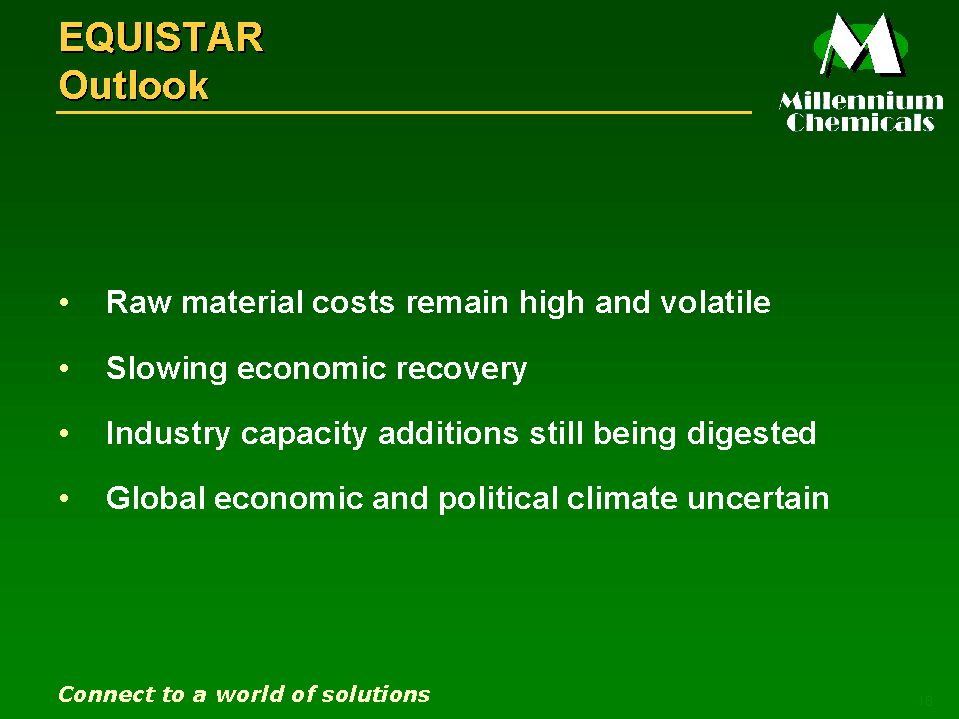
While Equistar entered the third quarter with good momentum, the latter portion of the quarter was impacted by rising raw material costs and what appears to be some slowing in the pace of the economy’s recovery. Industry supply/demand balances in the ethylene chain have not been adequate to quickly realize price increases that would offset high raw material costs. Global economic and political climates continue to be uncertain. Equistar’s near-term profitability depends on ethylene supply/demand balances and raw material costs, and these elements have placed pressure on Equistar’s performance. Now Bob will discuss growth prospects for Millennium Chemicals.
Robert E. Lee
Executive Vice President Of Growth and Development
Thank you Mickey. I’m going to describe the more growth oriented initiatives that are a key part of our strategy. This strategy relates to both existing and developing businesses that Millennium has identified as higher-growth and higher-margin business extensions that leverage our core competencies and technologies.
While we are not looking to transform the business overnight, we believe that over a reasonable period of time, we can substantially increase value and profitability that will come from the higher-margin businesses.
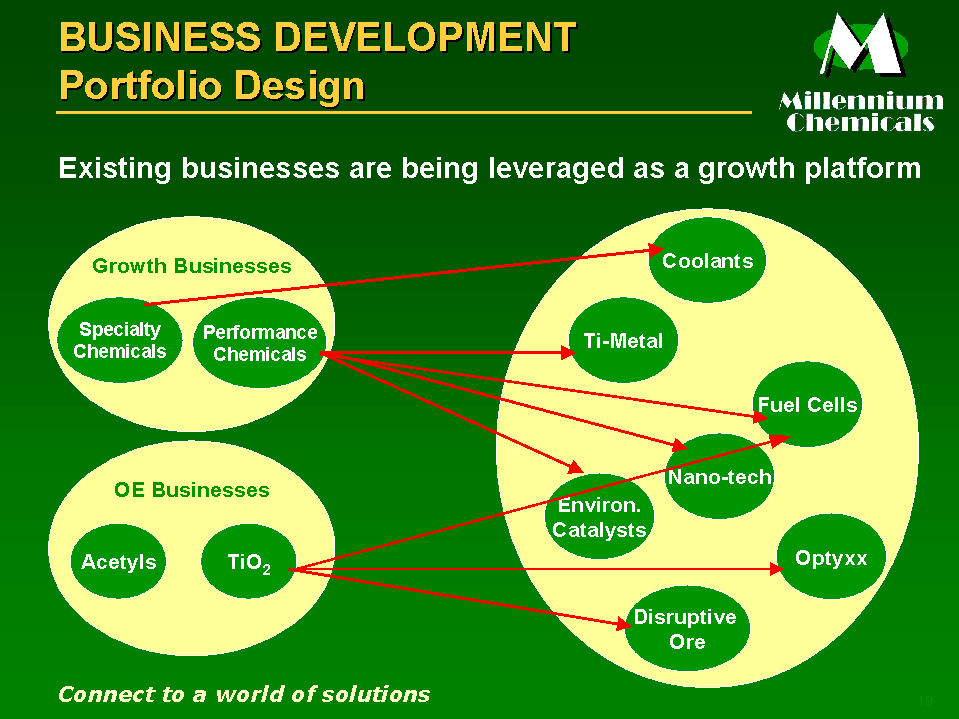
As this slide demonstrates, our identified growth opportunities relate to leveraging skills that are already present in our existing businesses. We have begun leveraging our competency platform, which includes gas and liquid particle formation, surface science and engineering, synthesized molecules, and inorganic compound extraction to create new business opportunities ranging from the new coolant molecules to direct titanium powder metal production. In most cases, we already have products or intermediaries in the market place.
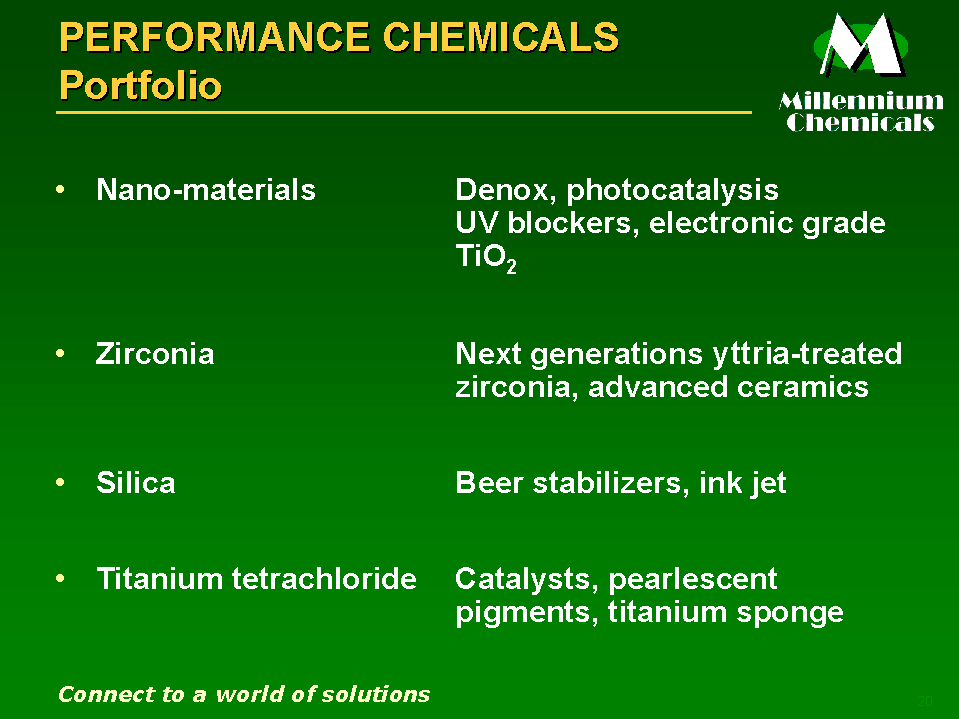
An already established science-based; higher growth business is our Performance Chemicals portfolio that is included in our TiO2 and related products segment disclosure. This business is currently generating sales of about $75 million annually and EBITDA margins in the mid-twenties. This slide lists several of our current products and the markets that we are either already participating in or are actively developing. Let’s discuss a few.
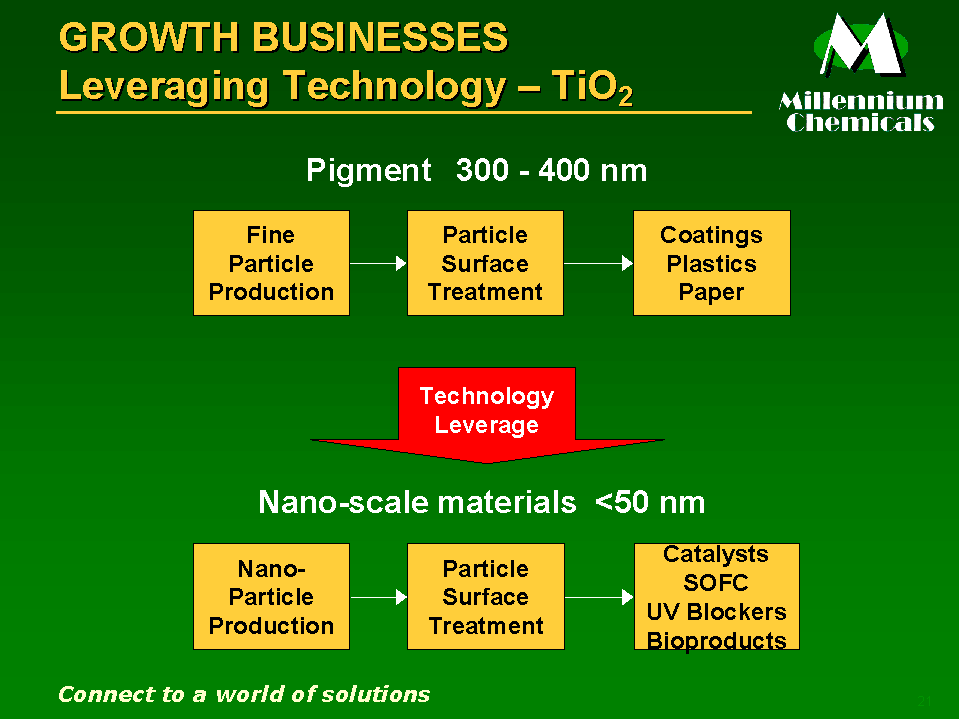
Over the years, we have developed and improved our competencies in the manufacture of micron-size materials in the 300 nano-meter range.
The particles we manufacture are design in a specific shape and finished with a coating relating to a specific application, such as coatings, plastics, or paper production. We have leveraged that know-how into nano-scale sized materials in the 50 nano-meter range to produce unique products for applications such as solid oxide fuel cells, UV blockers, and catalysts.
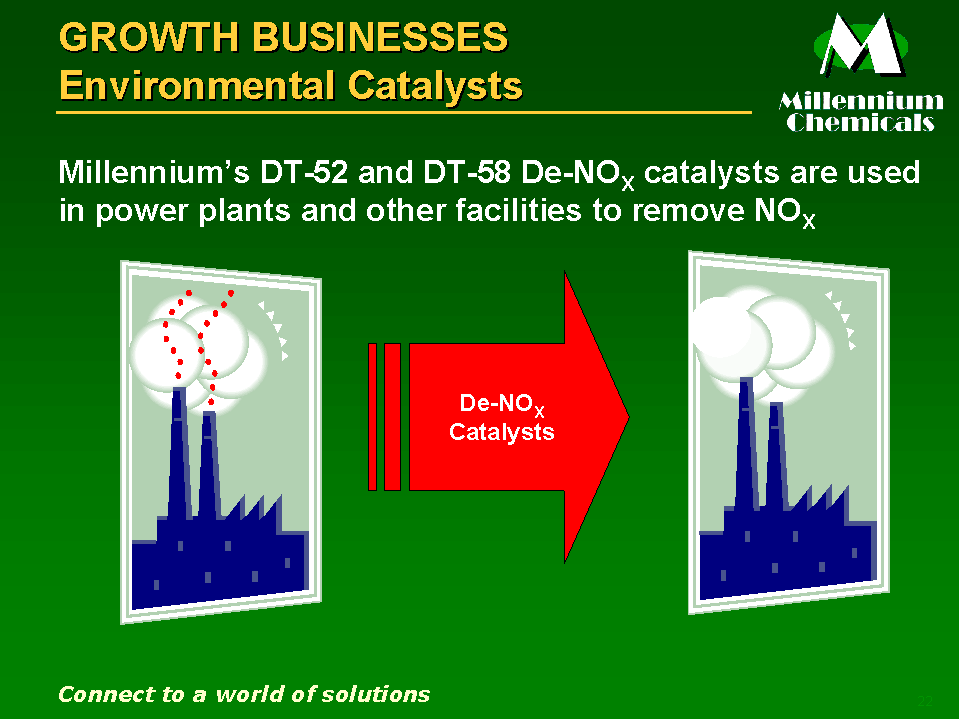
A specific example is our first generation of environmental catalyst products: DT-52 and DT-58. These products were designed to remove NOX gases from power plants and other facilities. Starting from almost nothing, we have built a business that is now approaching a $30 million annual revenue pace.
As Clean Air legislation becomes the norm globally, we believe we are well positioned to continue to grow of this business as well as leverage it to into other environmental improvement applications like coating highway sound barriers to neutralize certain auto emissions, an application currently being tested in Japan.
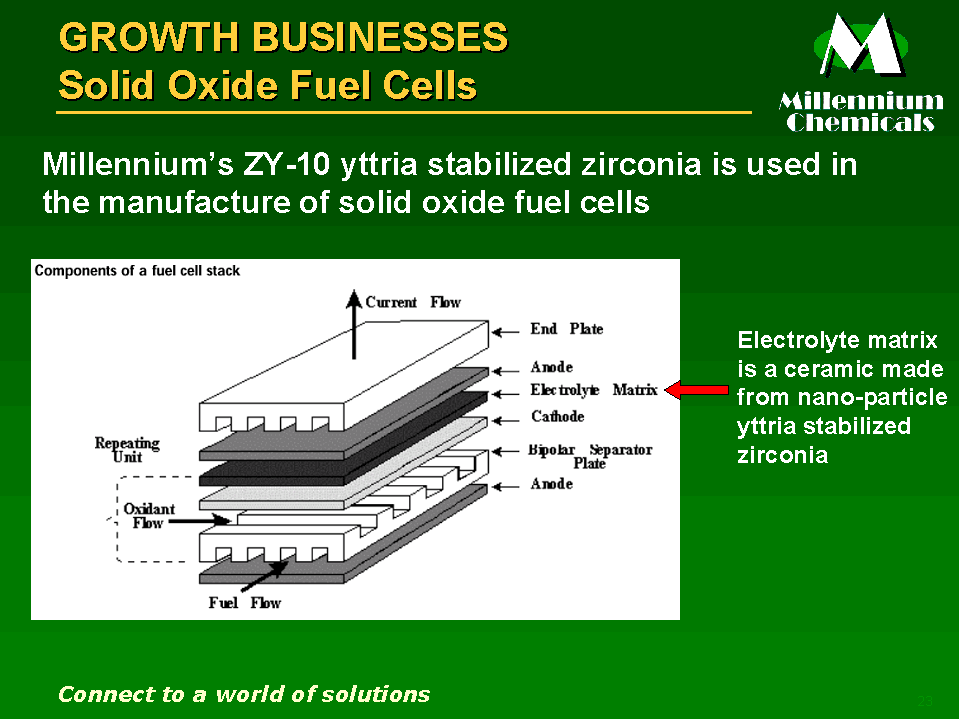
Another example, using the same technologies applied to zirconium oxides instead of TiO2 has led to the development of products designed specifically for the fuel cell market. Millennium yttria-stabilized zirconia was created specifically for production of electrolyte matrix at the heart of a solid oxide fuel cell stack. The market for solid oxide fuel cell systems is projected to grow to a $3.8 billion industry over the next ten years and we are talking to other materials producers about potential alliances where we can apply our process technology and scale-up experience to their pilot or lab-scale operations.
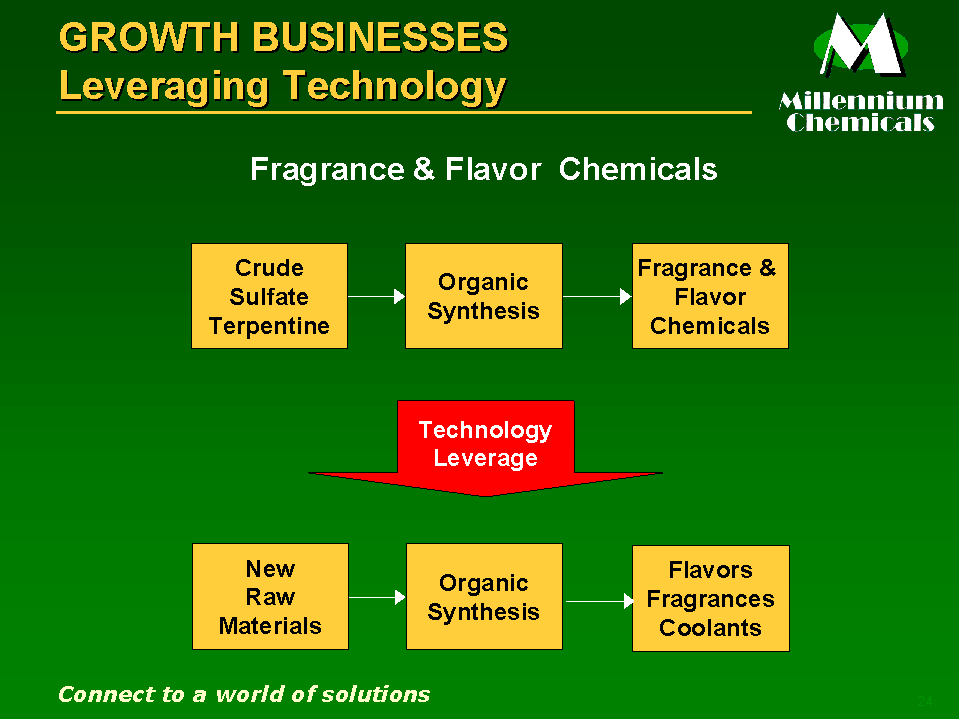
In the Specialties segment of our business, we have leveraged our terpene-based organic synthesis competency to start from other raw material sources and develop newflavor, fragrance and coolant molecules.
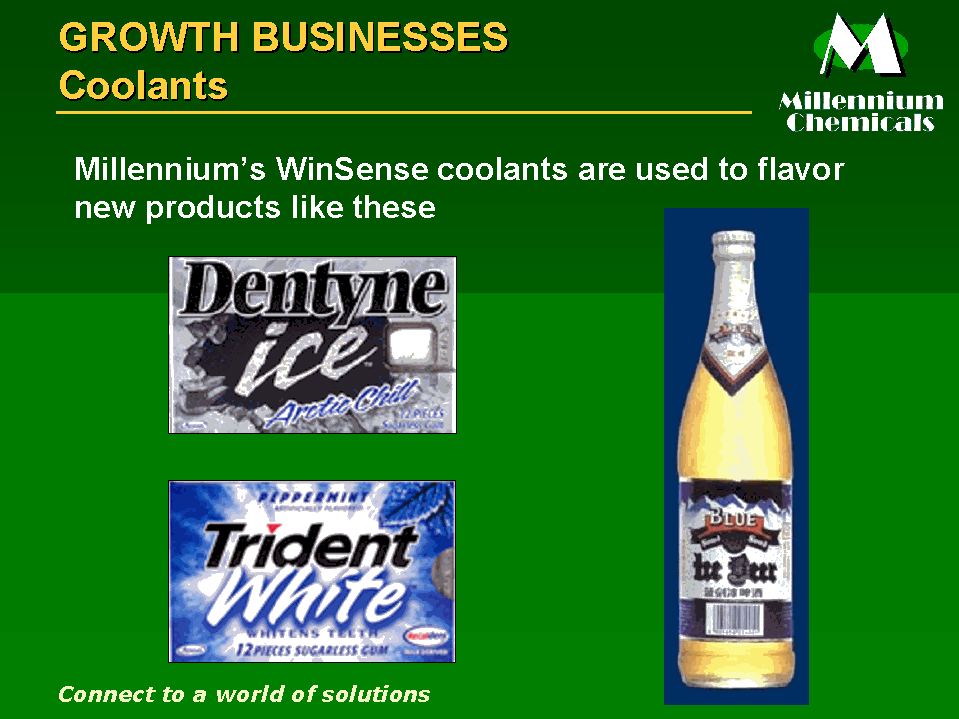
Our recent investments in R&D and capacity have focused primarily on new flavor and coolant chemicals. Those product lines were virtually insignificant in the past, but are growing rapidly and now account for over 18% of our gross margin in this segment. The coolants we produce that go into products like chewing gums and beverages are an especially important part of this. Because of our performance and reputation in this sector, customers like Proctor and Gamble are coming to us with requests to synthesize new molecules they have identified for commercialization. New higher margin products will be a key to growing this segment.
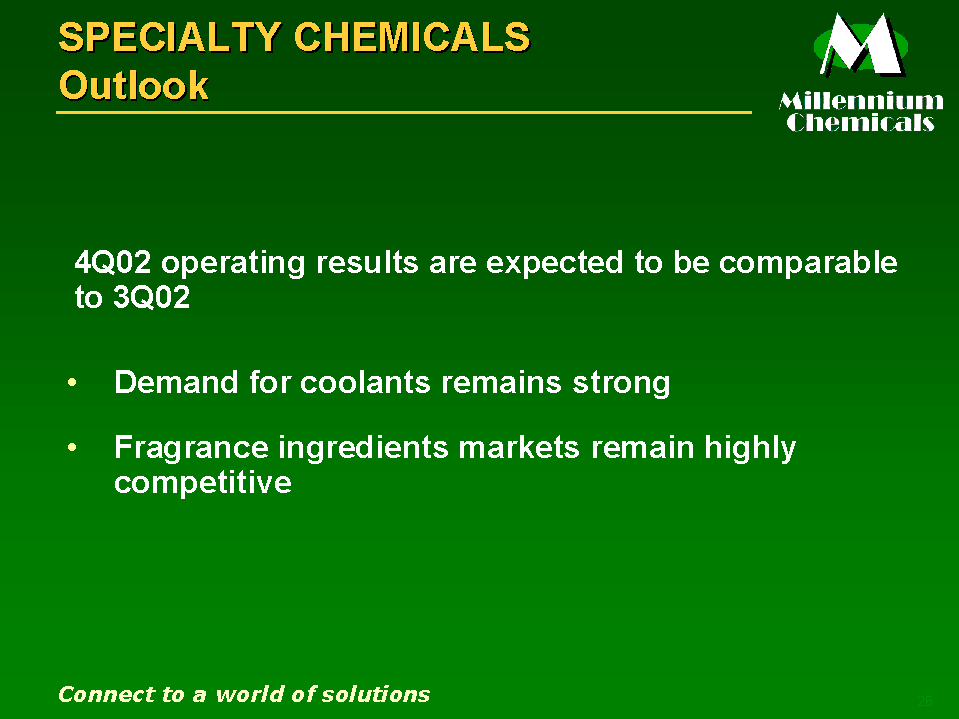
Looking forward we expect the forth quarter for Specialties to reflect results similar to the third quarter as our new product offerings sales are offsetting the effects of the very competitive fragrance markets. Feedstock markets in this segment are tight but relatively stable. Moving forward, we expect to generate profitable growth in both the fragrance and flavor ingredient sectors.
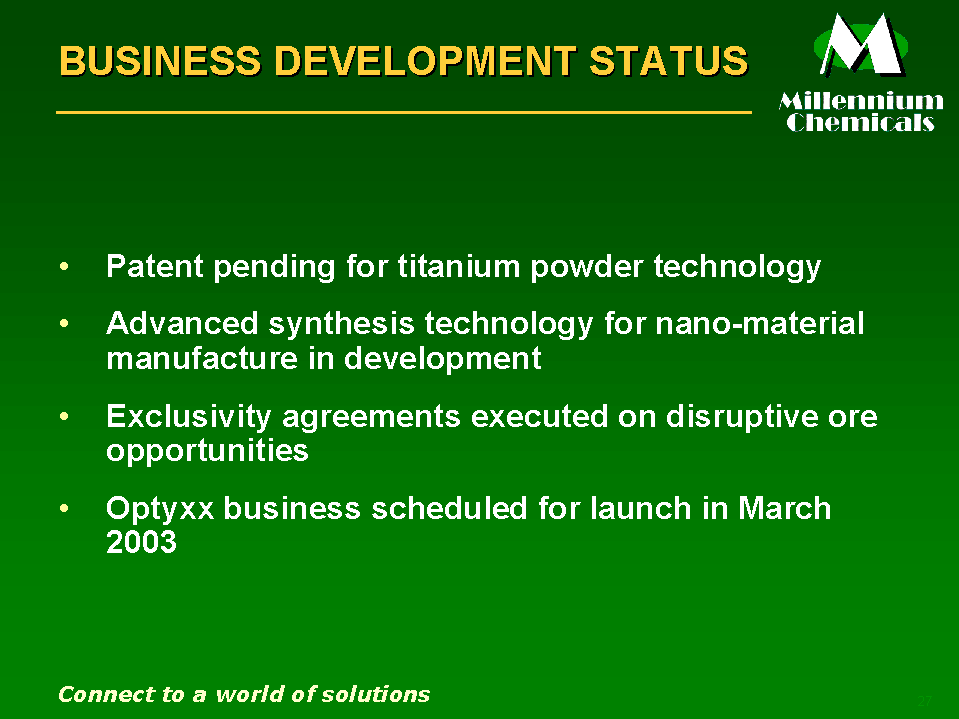
We don’t have sufficient time to discuss in any detail some of these other business development initiatives that we have already advanced from the concept to development stage gates, but examples of our progress are listed here. We have a patent pending for the direct manufacture of titanium metal powder that could dramatically reduce the cost of Ti-metals and open up a whole new market opportunity for Millennium.
On top of that, we are using our skills and competencies to accelerate and participate in unique titanium ore opportunities that could substantially change the game and the economics of the industry.
Not to forget the solution part of our business, after two years of development, we are on schedule to launch our Web-based process industry service business. Optyxx will provide subscription-based online production modeling, subscription-based product innovation services as well as fee-based diagnostic services. The business will be launched first to serve the paper industry but the diagnostics and high-throughput testing concepts the Optyxx model employs have potential for other process industry sectors.
Mickey Foster
Vice President, Corporate and Investor Relations Thanks, and now I'd like to open it up for questions and answers.If you were unable to hear the entire call, playback will be available until Wednesday, November 6th, by calling 973-341-3080, reservation #3524441 and you can access the speech and slides on the Internet athttp://www.millenniumchem.com. Thanks for listening, and if you have further questions please call.
